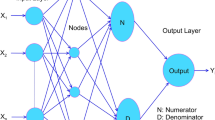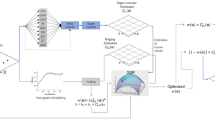Abstract
Mineral resource estimation is an integral part of making informed decisions while evaluating a mining operation’s feasibility. Geostatistical tools estimate geological features with the assumptions of first and second-order stationarity. Kriging is considered the best linear unbiased estimation technique for modelling geological features; however, in domains where data is non-Gaussian, and features are complex, the assumption of stationarity and the linearity of kriging can lead to suboptimal estimates. This manuscript presents a hybrid machine learning and geostatistical algorithm to improve estimation in complex domains. Elliptical radial basis function neural networks (ERBFN) take advantage of non-stationary functions to generate geological estimates. An ERBFN does not require the assumption of stationarity, and the only input features required are the spatial coordinates of the known data. The proposed hybrid estimation considers the machine learning estimate as exhaustive secondary data in ordinary intrinsic collocated cokriging, taking advantage of kriging’s exactitude while including the non-stationary features modelled in the ERBFN. The principle results of integrating geostatistics and machine learning indicate an improved estimation technique in domains with complex features, poorly defined domains, or non-Gaussian data. The major conclusion from this paper is that using the proposed hybrid algorithm can improve mineral resource estimations.












Similar content being viewed by others
References
Babak O, Deutsch C (2009) An intrinsic model of coregionalization that solves variance inflation in collocated cokriging. Comput Geosci 35:603–614. https://doi.org/10.1016/j.cageo.2008.02.025
Boutaba R et al (2018) A comprehensive survey on machine learning for networking: evolution, applications and research opportunities. J Internet Serv Appl 9(1):1–99
Daniels EB (2015) Prediction of local uncertainty for resource evaluation. Master’s thesis, University of Alberta
Deutsch J, Deutsch C (2012) A new version of kt3d with test cases. Centre Comput Geostat Ann Rep 14:403–410
Deutsch CV, Journel AG (1992) GSLIB: geostatistical software library and users guide. Oxford University Press, Oxford
Elboher E, Werman M (2012) Efficient and accurate Gaussian image filtering using running sums. In: 2012 12th international conference on intelligent systems design and applications (ISDA). https://doi.org/10.1109/isda.2012.6416657
Goovaerts P (2011) Geostatistics for natural resources evaluation. Oxford University Press, Oxford
Graden R (2013) Ni 43-101 technical report teck highland valley copper. Teck Ressources Limited Inc., Vancouver
Kingma DP, Ba J (2014) Adam: a method for stochastic optimization. 1412.6980
Mak MW, Li CK (1999) Elliptical basis function networks and radial basis function networks for speaker verification: a comparative study. In: IJCNN’99. international joint conference on neural networks. Proceedings (Cat. No. 99CH36339), vol 5, pp 3034–3039. https://doi.org/10.1109/IJCNN.1999.836039
Manavazhahan M (2017) A study of activation functions for neural networks. Master’s thesis, University of Arkansas, Fayetteville
Musumeci F et al (2019) An overview on application of machine learning techniques in optical networks. IEEE Commun Surv Tutor 21(2):1383–1408. https://doi.org/10.1109/COMST.2018.2880039
Northcote B (2019) Exploration and mining in the South Central Region, British Columbia. In: Provincial overview of exploration and mining in British Columbia. https://www.semanticscholar.org/paper/Exploration-and-mining-in-the-South-Central-Region%2C-Northcote/38a396fb7f6b4b2a212ba82157cda6529adb48f0
Pawlowsky V (1989) Cokriging of regionalized compositions. Math Geol 21(5):513–521. https://doi.org/10.1007/bf00894666
Raschka S (2018) Model evaluation, model selection, and algorithm selection in machine learning. Technical report, University of Wisconsin–Madison. https://arxiv.org/pdf/1811.12808.pdf. Accessed 1 Sept 2020
Rossi ME, Deutsch CV (2016) Mineral resource estimation. Springer, Berlin
Rusu C, Rusu V (2006) Radial basis functions versus geostatistics in spatial interpolations. In: IFIP international federation for information processing artificial intelligence in theory and practice, p 119–128
Silva D (2018) Enhanced geologic modeling of multiple categorical variables. Ph.D. thesis, University of Alberta
Todeschini R et al (2013) Locally centred Mahalanobis distance: a new distance measure with salient features towards outlier detection. Anal Chim Acta 787:1–9
Williams N, Holtzhausen S (2001) The impact of ore characterization and blending on metallurgical plant performance. J South Afr Inst Min Metall 101(8):437–446
Acknowledgements
The authors thank the industrial sponsors of the Centre for Computational Geostatistics (CCG) for financial support.
Author information
Authors and Affiliations
Corresponding author
Rights and permissions
About this article
Cite this article
Samson, M., Deutsch, C.V. A Hybrid Estimation Technique Using Elliptical Radial Basis Neural Networks and Cokriging. Math Geosci 54, 573–591 (2022). https://doi.org/10.1007/s11004-021-09969-3
Received:
Accepted:
Published:
Issue Date:
DOI: https://doi.org/10.1007/s11004-021-09969-3




